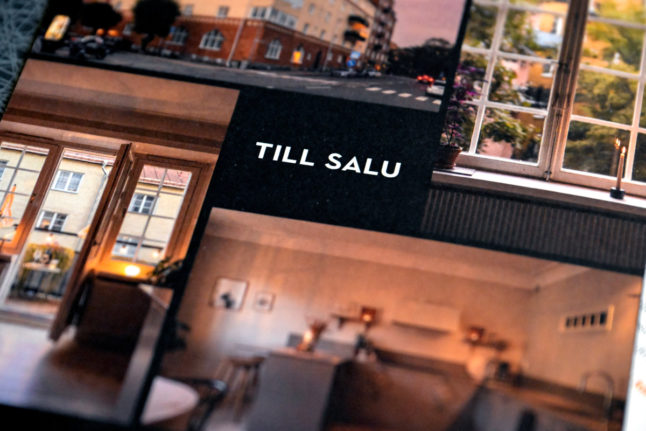Get to grips with the system
As with any process, when it comes to buying an apartment in Sweden there is a specific set of rules to follow.
Usually in Sweden, it’s a good idea to get a lender’s note from a bank before you start attending viewings, and be prepared for the bidding process to begin soon after the viewing, and to be concluded quite quickly (in most cases, at least).
In the past year the market has been quite slow, with many sellers struggling to get anyone to make an offer on their apartment, so if you’re interested in a property you may have more time than you normally would. That said, the market appears to be picking up pace again.
If you haven’t yet got your head around the way the system works in Sweden, you can start by reading The Local’s guide here.
Look for the best deal on your mortgage
When applying for your lender’s note (lånelöfte), it’s worth shopping around to see which offers you can get from different banks, since the bank you have a current account with may not always offer the best deal. So compare them online before actually applying.
It’s possible to take out several lånelöften. Multiple loan applications means multiple credit reports, although this shouldn’t have a negative effect if your finances are otherwise good. You can however choose to go through a loan broker if you’re worried, which means only one credit report will be made, but does cost extra money.
You don’t actually have to take out your loan with the same bank that gave you a lånelöfte, if you later find a better deal elsewhere.
Union members are often eligible for lower rates as well, and you can contact your union directly to find out more. Since mortgages are typically high, it may even be worthwhile to join a union if you’re not already a member in order to be eligible for the discounted rates.
READ ALSO: Should you join a union as a foreigner in Sweden?
Do further research
Checking out the apartment isn’t just about how it looks, and as a newbie to Swedish society, it can be a challenge to adjust to the system of the housing association (bostadsrättsförening, or simply BRF). There are benefits to this system – for example, it would be the association’s responsibility to fix any problems affecting the “four walls” of the building such as a broken window or plumbing issue. But it also means there are extra things to be aware of.
Apartment blocks undergo certain kinds of maintenance every so often, which can be an inconvenience when you’re living there. Check when the building last had a stambyte (replumbing). You should also find out if any renovations are scheduled for the outside of the building (fasad).
And do your research into any planned building works in the general area (you can find this information via your local municipality, or simply ask the estate agent).
Think about things like how construction works might disrupt your life, but also whether the finished project would improve or decrease your quality of life, if you’re thinking of the apartment as a long-term investment.
For example, if a tunnelbana station will be opening near the apartment in five years’ time, that would be convenient if you plan to stay long-term and would likely mean your apartment will stay stable or increase in value, but think carefully about the impact of the construction works on your life in the meantime. Be aware that despite stereotypes of Swedish efficiency, construction projects are not always finished at the projected time (especially long-term ones).
Check the building’s finances
On the financial side, it’s important to look into the BRF’s economic state.
If the BRF has high debts, this leaves it vulnerable to changes to the Swedish economy and interest rate, which could force them to raise your monthly service charge (avgift). High debts are most common with newbuild apartments as well as any which have recently undergone major renovations. You can also check the website Alla BRF which gives information about each BRF and gives them an overall grade; these grades are often shown on property site Hemnet too.
Bear in mind that any planned works in the building will cost the BRF money as well as being a potential inconvenience, so they could lead to an increased avgift in future.
You may also want to ask about how many apartments in the building are hyresrätter (first-hand rentals) and how many are bostadsrätter (privately-owned apartments). The best-case scenario is having some hyresrätter which are soon to be converted into bostadsrätter, which is generally positive for the BRF’s finances.
HOUSING ESSENTIALS:
View the apartment thoroughly
When viewing the apartment, don’t get caught up in the estate agent’s spiel – or the beautiful home-styling that many buyers invest in. If possible, take a tape measure with you to check areas so you can be confident your furniture will fit, and take lots of photos.
Look carefully at how the space is used, and if you already own furniture, think about how it could fit into the area. If the apartment has a particularly quirky layout and has furniture that fits it perfectly, you might consider asking if any of those items could be included in the sale.
Head to the windows. You’ll want to check how easy it is to see into the rooms from outside (if you can see into the neighbours’ kitchen, they can probably see into yours), and to open the windows if possible to check the sound level from outside. Are the windows double- or triple-glazed, and are there any obvious sources of noise nearby, such as preschools, pubs, busy roads, or train stations? Think about how much natural light the apartment gets, and where the sun will be in the apartment at different times of day.
Make sure to check your mobile signal while in the apartment too, since that’s something that’s likely to affect your day-to-day life but can be easily missed at a viewing.
Think about storage
In the big cities, Swedish apartments are often small and that’s especially true for first-time buyers, so think carefully about where you’d store your clothes, where bulky items such as vacuum cleaners and laundry baskets would go, and whether there’s enough surface area in the kitchen to cook comfortably.
If storage room in a cellar or attic is included, make sure to have a look at that space too. Think about the size of the space as well as security (is the area shared with any neighbouring buildings, and do you need a special code or fob to enter?) and potential worries like damp or pests.
Test the appliances
Make sure to check as many appliances as possible (the oven, fan, stove, and so on), and test water pressure in the taps and shower. And ask what’s included in the sale; in Sweden it’s common to leave behind appliances such as washing machines and dishwashers, but make sure to get that confirmed.
Investigate the amenities
When you buy an apartment in Sweden, you get access to shared spaces which almost always include a laundry room (tvättstuga) and often storage for bicycles or pushchairs (cykelrum or barnvagnsrum). Some apartment blocks have extra perks such as a shared events room, sauna, gym, or guest apartments, and if those are part of the appeal you should check them out, looking both at their condition and security. If you have a car, make sure to ask about garages and parking spaces too.
And have a look at the general common areas too: the lobby and stairwell, shared balconies, and the garden or courtyard. Think about how well cared-for they are, and ask about any planned renovations to common areas, since these could push up your monthly fee. Having access to an elevator is important for many people, including those who use wheelchairs or pushchairs, but you’ll need to check the size and ask how recently it was last renovated.
Look out for red flags
It can be easy to get caught up in a beautiful view or a traditional tiled stove, but try not to. Remember to assess the apartment critically, and look out for the things which would negatively impact your quality of life there.
Some of the things which can be hardest (and most expensive) to deal with are water damage, ventilation issues, and pests, so look carefully for signs of those. That means thinking and asking about the air quality, checking for signs of mould and looking for signs of pests (check around the toilet and sink or bathtub, as well as along floor moldings and in kitchen cupboards).
Are renovations needed?
Going for an apartment which needs some work can be a way to get a good deal, but of course you should factor in the potential costs to your calculations. Re-painting a wall isn’t too difficult or costly, but refitting a kitchen or restructuring the floor plan are significant projects.
If an apartment is the right size but wrong layout for you, you might plan to remove or add walls, and you’d need to know which of the walls are load-bearing and look at where the windows are to work out which options would be possible. You’ll also want to ask about the building association (BRF)’s own rules about restructuring.
Ask questions
Think about the things that might not be obvious from a viewing but would affect your day-to-day life if you moved in. You can approach the estate agent for questions, or speak to someone from the board of the housing association.
Some of the things you might want to find out include the building’s rules regarding pets and smoking, the temperature indoors in different seasons, and whether the radon level has been measured.
You probably already know that in addition to paying towards your mortgage each month, you’ll also be charged a monthly fee (avgift) by the building association. It’s important to ask exactly what’s included in that fee, since it often covers things like heating and TV, but not always. Is internet included? And how does the heating work? Electric radiators in particular can mean higher costs in the winter, if electricity isn’t covered in the avgift.




 Please whitelist us to continue reading.
Please whitelist us to continue reading.
Member comments